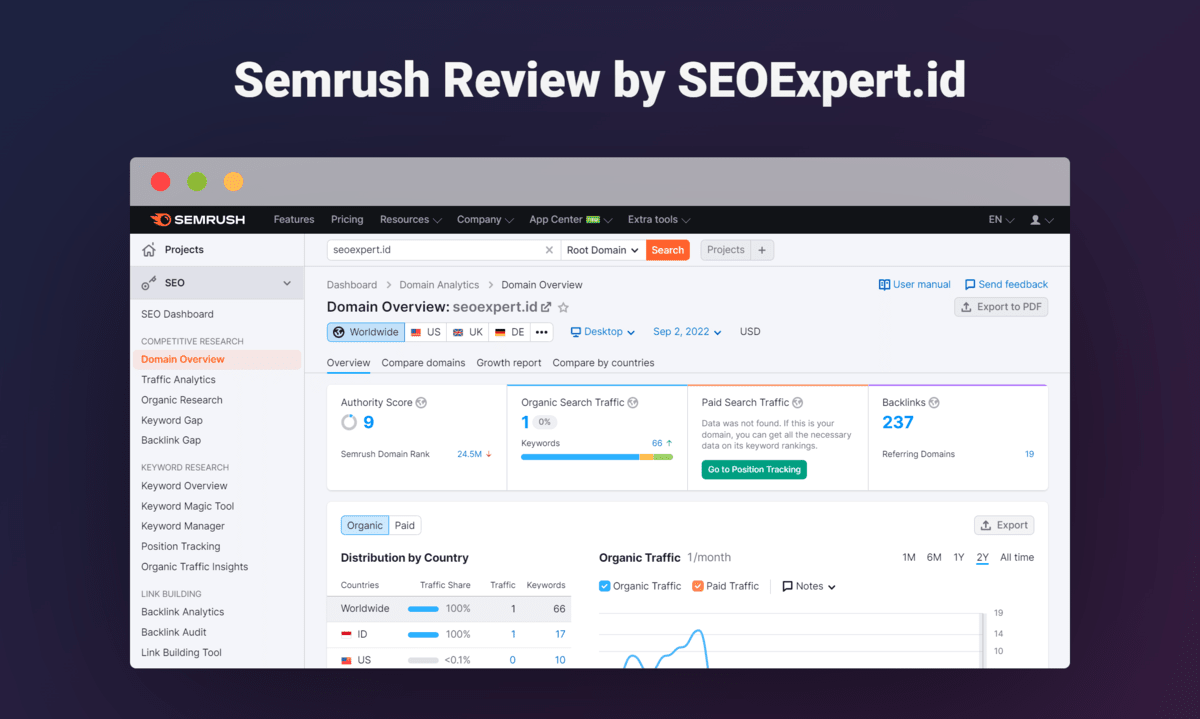Many individuals believe that SEO is too difficult and not worth the effort. That is not correct. SEO principles are actually fairly easy. And, with Google accounting for 57.8 percent of all web traffic, it’s surely something worth studying about if you own a website.
Namecheap
Find your perfect brand domain and claim it now to boost your SEO. Start from as low as $5 per year.
Think again if you believe that the fundamentals are insufficient to get you rated. Most website owners have a very limited grasp of SEO, so learning the fundamentals will undoubtedly help you succeed.
Let’s start with the fundamentals of SEO, such as why it matters and how it compares to other marketing methods.
The Importance of SEO in Digital World
The majority of online traffic is generated by Google’s organic results.
In other words, organic search generates more traffic than all other sources combined.
If you’ve read our explanation on how search engines function, you’ll know that Google and other search engines rank pages depending on hundreds of signals. SEO is crucial since it is the act of increasing the visibility of these signals in organic search results.
What are the advantages of SEO?
The most lauded advantage of SEO is improved rankings, yet rankings are really a means to an aim. Many of the genuine advantages of SEO are traffic-related.
1. SEO Increases Web Traffic Organically
Because most people click on the first few search results, ranking higher generally leads in greater traffic to your website.
Consider the top three results for “submit website to search engines.” We can observe from Ahrefs’ Keywords Explorer that the top-ranking page appears to receive the most organic traffic, followed by the second, third, and so on.
Our research shows that these findings are typically true across the board, since ranking position closely corresponds with overall traffic to a website.
2. Consistent Traffics in Long-Term
Search engine rankings typically result in both consistent and passive traffic. That is rarely the case with platforms like social media and email marketing, which frequently result in traffic spikes that swiftly go away.
This occurs because social media networks are structured to highlight new material. Emails are frequently marked as read, forgotten, or end up in the spam folder.
However, because the volume of searches made on search engines is often steady from month to month, traffic once you rank is both consistent and passive.
3. Free Traffic from Search Engines such as Google
Unlike paid advertising, search traffic is ‘free.’
This is significant since search engine advertisements may be costly.
According to Ahrefs’ Site Explorer, the Ahrefs Blog receives an estimated 390k monthly visitors from search engines. If we paid Google for that traffic, it would cost us almost $1 million each month.
Creating content that ranks in Google isn’t free, but it’s typically less expensive than paying for advertisements.
How can you get your website to appear on Google?
SEO can help you rank higher, but you can’t rank higher if Google doesn’t even know your website exists.
Google will ultimately discover your website on its own, but there are a few important advantages to actively submitting your site:
Quicker discovery. Because most new websites lack backlinks from other websites, it may take some time for Google to discover them.
Enhance your website. Google Search Console provides advice on how to improve and optimize your website.
Finding your sitemap is the first step in submitting your website to Google.
Sitemaps are files that detail all of your website’s key pages. You can generally discover it by entering one of the following URLs into your browser:
- site.com/sitemap.xml
- site.com/sitemap index.xml
If it isn’t there, go to site.com/robots.txt, where it should be.
If it’s not there, you most likely don’t have one. You can create a sitemap using the free XML Sitemap Generator tool. You can also create robots.txt file using the Robots.txt Generator or Blogger Robots.txt Generator.
The second step is to sign up for Google Search Console and submit your sitemap.
You can also read our full guides on how to submit your site to search engines.
How to Sucessfully Setting up for SEO
Having your website indexed by search engines implies you’re in the race, but it doesn’t imply you’re going to win. This is where SEO comes into play. SEO is a continuous process that, if done correctly, boosts your chances of success over time.
When your website is correctly set up for SEO success, it is much easier to execute SEO well.
Let’s have a look at how to accomplish this.
- Get a good domain
- Use a website platform
- Use a good web host
- Create a positive user experience
- Create a logical site structure
- Use a logical URL structure
- Install a good SEO plugin
Get an excellent domain name
If you’ve already registered a domain, don’t worry. It’s probably OK and won’t interfere with your SEO attempts. But, if you haven’t picked one yet, keep these two characteristics of an excellent domain in mind:
1. The domain name
To begin, don’t be concerned about include your keywords. For search engines to comprehend what your website is about, your domain name does not have to be londonitalianrestaurant.com.
Here are a few characteristics of an excellent domain:
- Is the name of your company
- There are no hyphens.
- Is brief and memorable
2. TLD
TLD is an abbreviation for top-level domain. It’s the section that comes after the name, such as.com,.org, or.co.uk.
According to Google’s John Mueller, your TLD has no impact on SEO. However, if you can acquire it,.com is typically better for most businesses because it is the most known and reputable.
If you’re a nonprofit, you may use.org or your country’s equivalent (for example,.org.uk).
If you only do business in one nation other than the United States, your ccTLD (for example, co.uk) will suffice.
It’s definitely preferable to avoid TLDs like.info and.biz, which are associated with low-quality websites, but having one isn’t the end of the world. You may still create a reputable, ranking website.
Make use of a website platform
The majority of individuals do not build their website from the ground up with HTML and CSS. They make use of a website platform. These are pieces of software that enable anyone with little or no coding experience to develop a website, maintain content easily, and handle tedious technicalities.
Website platforms are classified into two sorts.
Platforms that are Hosted
Everything is done under one roof using hosted platforms. They host your website, give ready-made designs that you can easily install and change, and allow you to produce and manage content without touching code.
Platforms that are Self-hosted
Self-hosted platforms also enable you to manage and produce content without the need of code. The distinction is that you must host and install them yourself.
Which platform should you go with?
Most SEO experts advise using a self-hosted, open-source platform like WordPress because:
- It’s adaptable because open-source code may be edited whatever you want, and there’s a large community of developers who know the platform thoroughly and out.
- It is extendable because millions of ready-made plugins, including hundreds of SEO plugins, may increase its usefulness.
If you want our advice, go with a self-hosted option like WordPress.
A hosted option, such as Wix or Squarespace, may be a better choice if you value simplicity of use and support. The reality is that most well-known hosted systems give more than adequate SEO skills for the majority of consumers.
So, if you’re already using another platform, don’t be concerned about switching to WordPress.
Strong Web Hosting is Recommended
Your website is stored on a hard disk that anybody with an internet connection may view.
You have very little control over your hosting if you choose a hosted platform for your website. However, if you’re using a self-hosted platform like WordPress, you’ll need to locate a place to host it.
So, how do you pick a decent web host to support your SEO efforts?
Most SEO recommendations recommend dedicated hosting over shared hosting. That is correct, but it won’t make much of an impact until your website receives a lot of visitors. Most consumers can get by with cheap hosting from any trustworthy firm; there isn’t much of a difference in performance between hosts when you’re only paying a few dollars per month.
However, there are a few aspects that are crucial:
- Security. Check if the server provides a free SSL/TLS certificate or supports LetsEncrypt, a non-profit that provides free TLS certificates.
- The server’s location. Because data travels slowly between the server and the visitor, it’s ideal to select a host with servers in the same country as the majority of your traffic.
- Support. 24/7 assistance is great. Before you sign up, ask the above questions to see how good their customer service is.
Make the user experience enjoyable
Google prefers to rank pages that provide visitors with a favorable experience. According to their SEO beginning guide:
You should design a website to benefit your visitors, and all optimization should be aimed towards improving the user experience.
Here are a few easy methods to accomplish this:
Make use of HTTPS
Nothing is worse for visitors than having their personal information compromised by hackers. Always use SSL/TLS to encrypt your website.
Select an attractive design
Nobody likes a website that appears to have been developed in the 1990s. While your website does not need to be redesigned every six months, it should be visually appealing and reflect your brand.
Make certain that it is mobile-friendly
According to Google, more searches are now made on mobile than on desktop, therefore it’s vital that your website be as user-friendly on mobile as it is on desktop.
Use a legible font size
Nowadays, people use a variety of gadgets to access the internet. Make certain that your material is viewable on all platforms.
Avoid annoying pop-ups and advertisements
Everyone despises advertisements, yet they are occasionally necessary. If that’s the case, the trick is to avoid those that are too obtrusive. Google gives some suggestions for what is and isn’t acceptable in this situation.
Make certain that it loads quickly
Page speed is a proven ranking factor for both desktop and mobile. However, this does not imply that your site must load lightning quick. Sure, faster is better, but Google claims that this criteria only applies to sites that “provide the slowest experience to visitors.”
Make a site structure that is logical
Both users and search engines must be able to traverse your site simply and intuitively, which is why a logical structure for your content is essential.
The simplest approach to accomplish this is to create a mental map.
Each branch in your mind map will be converted into an internal link, which is a link from one page on a website to another.
Internal links are important for UX and SEO for several reasons:
- They aid search engines in discovering new pages. Pages that lack internal connections are seldom discovered and indexed.
- They aid in the spread of PageRank throughout your site. PageRank is the core of Google’s ranking system, which attempts to evaluate a page’s “worth.”
- They assist search engines with determining the topic of your page. For this, Google examines link anchors and surrounding content.
Make use of a sensible URL structure.
URLs are significant because they assist searchers in understanding the content of a page.
Many website platforms allow you to customize the format of your URLs. These are the five primary URL choices in WordPress:
- URL ID: site.com/?p=123
- Day and name: site.com/2021/03/04/seo-basics/
- Month and name: site.com/03/04/seo-basics/
- Numeric: site.com/865/
- Post name: site.com/seo-basics/
If you’re starting from scratch, the cleanest and most descriptive structure makes the most sense. That’s most likely Post’s name.
Using dates in URLs is also not recommended because you may wish to edit the postings in the future.
Even if the URL structure isn’t perfect, it’s usually advisable not to modify it while optimizing an existing website. This can break other more critical things, which will have a far greater negative influence on your SEO.
By this point, you should have a solid foundation for SEO success. However, this is merely the beginning. SEO is a continuous process with four major components:
Keyword investigation
SEO on-page
Creating connections
SEO for technical purposes
We’ve written beginner’s instructions for each of these aspects, so we won’t go into detail here. Instead, we’ll focus on the fundamentals and take a high-level look to help you grasp why each aspect is critical and how everything works together.
Keyword Research
Keyword research is the process of discovering what your consumers are looking for, how much traffic those phrases might bring you, and how tough it may be to rank for them. Let’s go through the fundamentals of each of those processes.
Find keywords
The first step in keyword research is to determine what types of items your potential clients are looking for. You can’t even start creating sites that will rank in search engines and draw significant visitors unless you know this.
The easiest approach to begin this process is to brainstorm terms and phrases that describe your sector. For an online computer store, they might include:
- computer
- PC
- mac
- laptop
- macbook
These can then be used as’seed’ keywords to generate more ideas. Simply enter them into a keyword research tool, such as Ahrefs’ Keywords Explorer, and review one of the keyword suggestions reports.
Look for keyword suggestions that are relevant to your business.
Check traffic potential
Almost every keyword research tool, including Ahrefs’ Terms Explorer, will display projected monthly search volumes for the keywords it discovers.
Search volume is typically a good indicator of a keyword’s relative traffic potential. Pages that target high-volume keywords will often attract more traffic to your website than pages that target low-volume keywords.
However, keyword search volume is not infallible. In certain cases, ranking first for a term with 1,000 monthly searches will result in more traffic than ranking first for a keyword with 2,000 monthly searches.
“Submit website to search engines,” for example, vs. “seo recommendations.”
Despite having a greater search volume, the latter’s top-ranking page receives more organic visitors.
To gain a better understanding of a keyword’s traffic potential, check at anticipated organic traffic to the top-ranking page. This is possible in Keywords Explorer.
Check ranking difficulty
Even if a term appears to be related to your organization and has significant traffic potential, ranking for it is not always straightforward.
Many factors influence a keyword’s ranking difficulty, but the quantity of relevant, renowned websites connecting to the top-ranked pages is perhaps the most crucial. Google discusses this in their search engine user guide:
If the page is linked to by other major websites on the subject, it is a positive indication that the content is of high quality.
We based Ahrefs’ Keyword Difficulty (KD) score on the amount of websites connecting to the top-ranking pages in part for this reason. It rates each keyword on a scale of 0-100 and is an excellent starting point for determining ranking difficulties.
However, because it is hard to reduce the complexities of grading difficulty to a 1-3 digit number, we do not advocate depending only on it. In our keyword research guide, we go into further depth regarding determining ranking difficulties.




